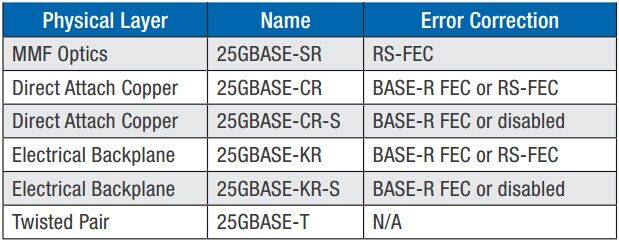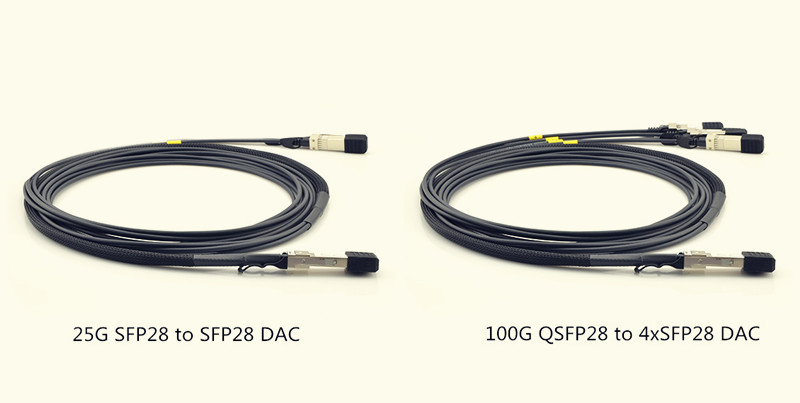Nowadays, the requirement for bandwidth in cloud data centres is increasing strikingly. To meet the demand for higher bandwidth, networking and the Ethernet industry are moving toward a new direction. Discussions previously focusing on 10GbE and 40GbE are now shifting onto 25GbE. It seems that 25GbE is more preferred and accepted by end users, which poses a threat to 10GbE and 40GbE. Why does it happen? This post will lead you to interpret 25GbE in an all-sided perspective.

25GbE is a standard developed by IEEE 802.3 Task Force P802.3by in July 2014, used for 25G Ethernet servers and 25GbE switch connectivity in a data centre environment. The single lane design of 25GbE gives it a low cost per bit, which enables cloud providers and large-scale data centre operators to deploy fewer switches and cables to meet the needs while still scaling their network infrastructure. The following table provides a summary of key upcoming IEEE standard interfaces that specify 25GbE.
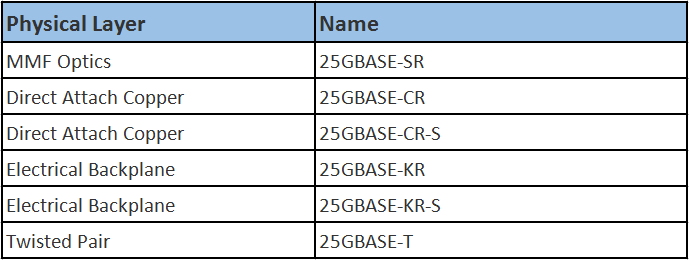
Figure 1: IEEE 802.3 standard Interfaces that specify 25GbE
The 25GbE physical interface specification supports two main form factors—SFP28 and QSFP28.
SFP28 is used for a single 25GbE port. The SFP28-25G-SR-S is an 850nm VCSEL 25GbE transceiver which is designed to transmit and receive optical data over 50/125µm multimode fibre (MMF) and support up to 70m on OM3 MMF and 100m on OM4 MMF.
The QSFP28 transceiver and interconnect cable is a high-density, high-speed product solution designed for applications in the telecommunication. The interconnect offers four channels of high-speed signals with data rates ranging from 25 Gbps up to potentially 40 Gbps, and will meet 100 Gbps Ethernet (4×25 Gbps) and 100 Gbps 4X InfiniBand EDR requirements.
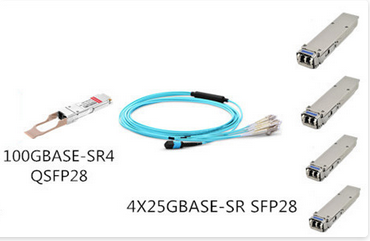
Figure 2: FS.COM optical transceivers for 25GbE solution
While 10GbE is fine for many existing deployments, it cannot efficiently deliver the bandwidth required by next-generation cloud and web-scale environments. And 40GbE isn’t cost-effective or power-efficient in ToR switching for cloud providers. Thus, 25GbE was designed to break through the dilemma.
SerDes is an integrated circuit or transceiver used in high-speed communications for converting serial data to parallel interfaces and vice versa. The transmitter section is a serial-to-parallel converter, and the receiver section is opposite. Currently, the rate of SerDes is 25 Gbps. That is to say, we can only use one SerDes lane at the speed of 25 Gbps to connect from 25GbE card to the other end of 25GbE card. In contrast, 40GbE needs four 10GbE SerDes lanes to achieve connection. As a result, the communication between two 40GbE cards requires as many as four pairs of fibre. Furthermore, 25 Gbps Ethernet provides an easy upgrade path to 50GbE and 100GbE networks, which utilise multiple 25GbE lanes.

Figure 3: Numbers of lanes needed in different Gigabit Ethernet
At present, the mainstream Intel Xeon CPU only provides 40 lanes of PCIe 3.0. The lane bandwidth of a single PCIe 3.0 is about 8 Gbps. These PCle lanes are used for many connections. Therefore, it is necessary to consider the utilisation of limited PCIe lanes by the network cards. Single 40GbE NIC needs at least one PCIe 3.0 x8 slot, so two 40GbE cards need to occupy two PCIe 3.0 x8 lanes. Even if the two 40GbE ports can run full of data at the same time, the actual lane bandwidth utilisation is only: (40G+40G) / 8G*16= 62.5%. On the contrary, 25GbE card only needs one PCIe 3.0 x8 lane, and then the utilisation efficiency is 25G*2 / (8G*8) = 78%. Apparently, 25GbE is significantly more efficient and more flexible than 40GbE in terms of the use of PCIe lanes.
25GbE enables resellers and their customers to provide 2.5X the performance of 10GbE, making it a cost-effective upgrade to the 10GbE infrastructure. Since 25GbE is delivered across a single lane, it provides greater 25GbE switch port density and network scalability compared to 40GbE, which is actually four 10GbE lanes. Thus, it costs less, requires lower power consumption and provides higher bandwidth. What’s more, 25GbE can run over existing fibre optic cable plant designed for 10, 50 or 100GbE and also 40GbE by changing the transceivers.
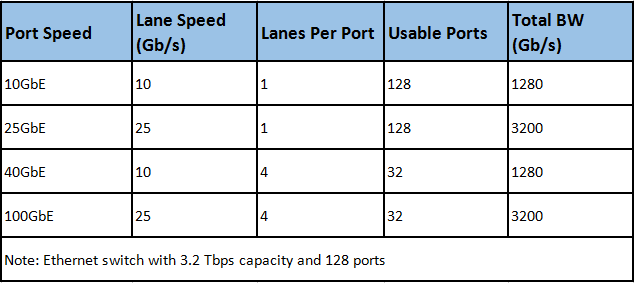
Figure 4: Bandwidth comparison for 25GbE and other Ethernet speeds
No matter the market research or the attitude of users, 25GbE seems to be the preferred option down the road. Actually, coming back to reality, there will be a significant increase in 100GbE and 25GbE port density in the next few years. If you need any optics and cabling solution for your 25GbE infrastructure, feel free to contact sales@fs.com.
Related Article: How to Use 25G Switch for Switch-to-Server Connection

